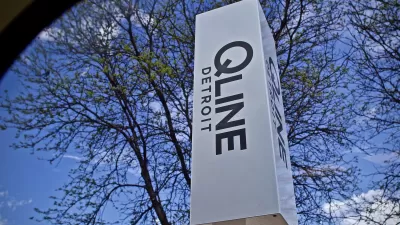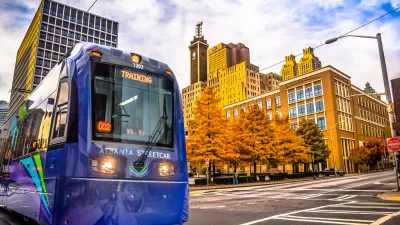Jim Epstein suggests that Detroit's new light rail line is America's largest boondoggle; Matthew Yglesias argues that that ignominy belongs to Washington D.C.'s planned streetcar.
Jim Epstein begins his article arguing against Detroit's forthcoming M-1 light rail line by faulting a romantic notion of urban settings: "downtown’s allure is an ongoing distraction from what’s actually important for the health of cities. It explains in part the twisted logic behind one of the most confounding urban development projects of our time, a $137 million 3.3-mile light rail line that breaks ground in Detroit next week."
Epstein's question: "How else could sane people think a bankrupt city should build a wildly expensive rail line on a partially deserted avenue in a neighborhood awash in cheap parking?"
More specifically: "How will the light rail line serve the 26 percent of Detroit households that don’t own cars and depend on the city’s dreadful bus service? Detroit has a 139-square mile footprint, but the light rail line will serve only those travelers who happen to be going from one spot to another along one three-mile stretch on Woodward."
Matthew Yglesias references the "many good points" of Epstein's article, but begs to differ on the ignominious title of biggest boondoggle: "The current fad for streetcar construction is actually bequeathing quite a large number of terrible projects to the country. And the very worst of these — like Washington, DC's maybe-opening-soon streetcar line — aren't just expensive, they actually make mass transit worse."
"The original sin of every bad streetcar program," according to Yglesias: "it doesn't have a dedicated lane." The article provides more evidence to back up the argument that streetcar projects like Washington D.C.'s work against the goals of transit.
FULL STORY: Is Detroit's New Light Rail Line America's Greatest Boondoggle?

Alabama: Trump Terminates Settlements for Black Communities Harmed By Raw Sewage
Trump deemed the landmark civil rights agreement “illegal DEI and environmental justice policy.”

Planetizen Federal Action Tracker
A weekly monitor of how Trump’s orders and actions are impacting planners and planning in America.

The 120 Year Old Tiny Home Villages That Sheltered San Francisco’s Earthquake Refugees
More than a century ago, San Francisco mobilized to house thousands of residents displaced by the 1906 earthquake. Could their strategy offer a model for the present?

Ken Jennings Launches Transit Web Series
The Jeopardy champ wants you to ride public transit.

BLM To Rescind Public Lands Rule
The change will downgrade conservation, once again putting federal land at risk for mining and other extractive uses.

Indy Neighborhood Group Builds Temporary Multi-Use Path
Community members, aided in part by funding from the city, repurposed a vehicle lane to create a protected bike and pedestrian path for the summer season.
Urban Design for Planners 1: Software Tools
This six-course series explores essential urban design concepts using open source software and equips planners with the tools they need to participate fully in the urban design process.
Planning for Universal Design
Learn the tools for implementing Universal Design in planning regulations.
Clanton & Associates, Inc.
Jessamine County Fiscal Court
Institute for Housing and Urban Development Studies (IHS)
City of Grandview
Harvard GSD Executive Education
Toledo-Lucas County Plan Commissions
Salt Lake City
NYU Wagner Graduate School of Public Service




























